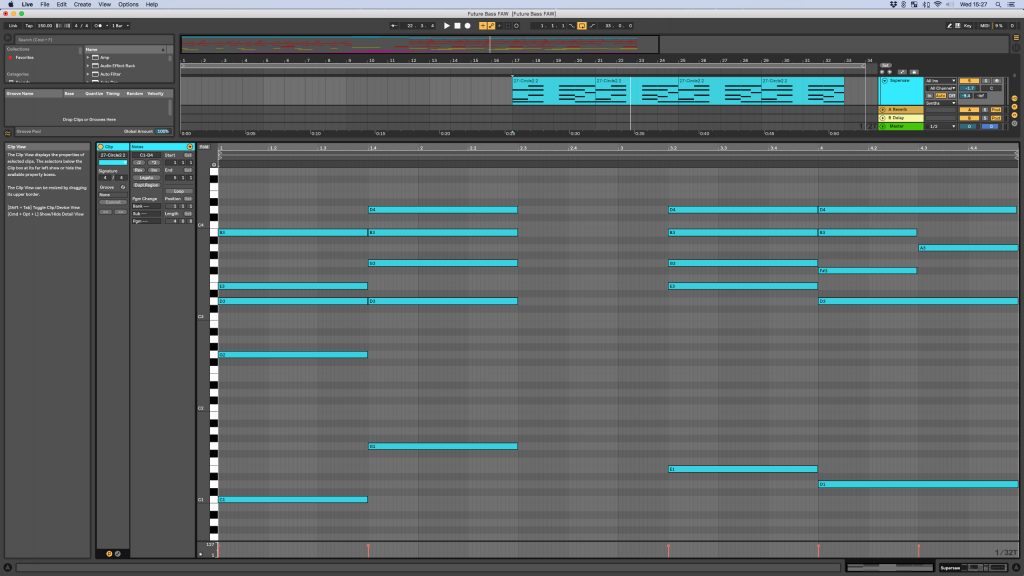What began as an amorphous patchwork of influences drawn from Dubstep, Trap and EDM, Future Bass has now become a fully-fledged genre. With the rise of artists like Flume, The Chainsmokers and San Holo, the sound of Future Bass has been conquering the airwaves.
I’ll take you through each step of how I made this Future Bass demo track, so you can hit the studio and try it for yourself.
But first, let’s take a quick dive into the origins, artists, and main ingredients of the genre.
Origins & Ingredients
If Future Bass had a family tree, EDM would be the mom, Dubstep would be the first cousin and Trap would be the second cousin with infinite sub-genres sprouting out. While Dubstep emerged out of the U.K. and Trap out of the American South, Future Bass emerged in the virtual hemisphere from underground producers on Soundcloud and Spotify. This is a tricky genre to pin down, but here’s a breakdown of the main ingredients.
- Melodically focused
- Highly compressed vocals and vocal chops
- Drops and risers that morphed out of dubstep
- Sawtooth and square waves
- 808 sub-bass, snare rolls and hi-hats derived from trap
- Polyrhythms and triplets
- Arpeggiated chords
- Filter and volume modulation
- Stabby chords
- 100-160 BPM
- Layers and layers of sounds
The Big Tunes
2013: Disclosure,“You & Me” (Flume Remix)
With supersaws, stripped back drums and pitched vocal chops, Flume’s remix of “You & Me” set the tone for the future of Future Bass.
Did we mention Flume uses Circle²? ?
2016: San Holo, “Light”
Influenced by the gigantic supersaw theatrics of EDM, San Holo applied the style to the Future Bass framework.
2016: The Chainsmokers, “Closer” (feat. Halsey)
Sitting at No.1 for 12 weeks in 2016, “Closer” (co-written by Frederic Kennet of Louis the Child) proved the genre’s potential for crossover success.
2017: Louis the Child,”Love is Alive” (feat. Elohim)
Chicago duo Louis the Child continued the genre’s evolution by stripping back the drums even more and layering melodies.
Building a Future Bass Track
Percussion
You may find 808 and 909 samples in Future Bass, but you can forgo retro sounds entirely to bring your sound firmly into the future. Use snappy and clean claps, snares, hi-hats and finger snaps, that don’t sound distorted or industrial. The internet offers up plenty of Future Bass drum packs; Splice, Arcade, and Sounds.com are great places to start searching.

As with Dubstep and Trap, Future Bass tracks use a snare on every third beat for a half time feel with rattling, closed hi-hats. To keep things funky, the beats are sprinkled with other percussion such as toms, open hi-hats, clicks and reversed cymbals. Quirky recorded sounds such as droplets, clicks and taps are also used.
Here’s the drum track I created:
Try downloading some unexpected sounds to process them into something new and unique. I processed a recording of somebody snipping with scissors from Freesound.org to create a loop that runs subtly under the whole track.
If you want to use tuned percussion, chuck the hit into a sampler so you can play it on the keyboard like I did with the toms.
Synths
Future Bass leads often feature euphoric chord patterns played using supersaws. A supersaw is a patch made of several detuned sawtooth waves layered together.

For this track I made a supersaw using Circle². The patch uses a sawtooth and a noise oscillator globally detuned and with a unison of 5 (5 sawtooth and noise oscillators stacked and tuned slightly apart). Pitch modulation is added using two LFOs, which are set to fade in gradually. Chorus is added in Circle² then an Ableton autofilter is automated to give the sound some serious movement.
So here’s the synth part I made:
For the intro, I used a couple of pad and riser presets from Circle² along with a piano Kontakt instrument which I low-passed and totally washed out with reverb.
Vocals
Chopping up a vocal and using it like an instrument is a hallmark of Future Bass. I grabbed a couple of one-shot vocals from a sample pack, chopped them up and put them in a sampler so I could play them on the keyboard. I used glide so that the pitch of each note leads into the next. Then I just jammed out a melody over the chords!

For the intro I used more vocal chops, with reverb and filtering to give an ambient and chilled out feel. At the end of the intro, I used the full vocal sample to transition into the drop, building energy and emotion that makes the transition hit hard.
Here are the processed vocals:
FX
Future Bass producers aren’t afraid to use FX like risers and impacts to make powerful drops and transitions. There are tons of FX packs out there, just dig around for the less obvious ones. Recognizing an FX one-shot you’ve heard a gazillion times before can be a vibe killer!

I used short and long risers and impacts to heighten the transitions, particularly into the drop, and removed unwanted high and low end frequencies using EQ.
Here’s what the drop transition sounds like:
Make your tunes truly unique by producing your own FX with synth or sample processing techniques. If you want to build a riser from scratch, check out my Roll your own Risers article.
The Finished Demo Track
I expanded the idea into an arrangement, adding and removing some elements along the way to keep things interesting.
And there we have it!

My finished Future Bass demo track:





